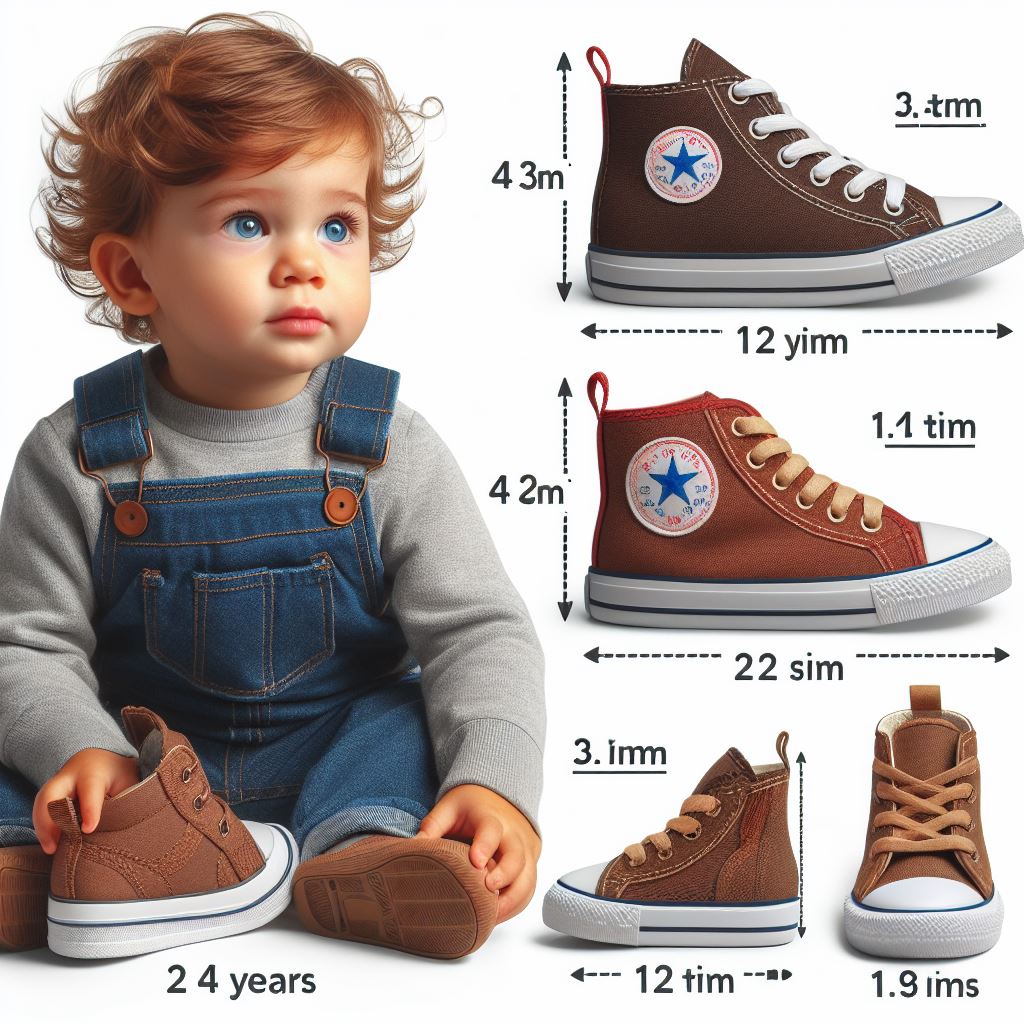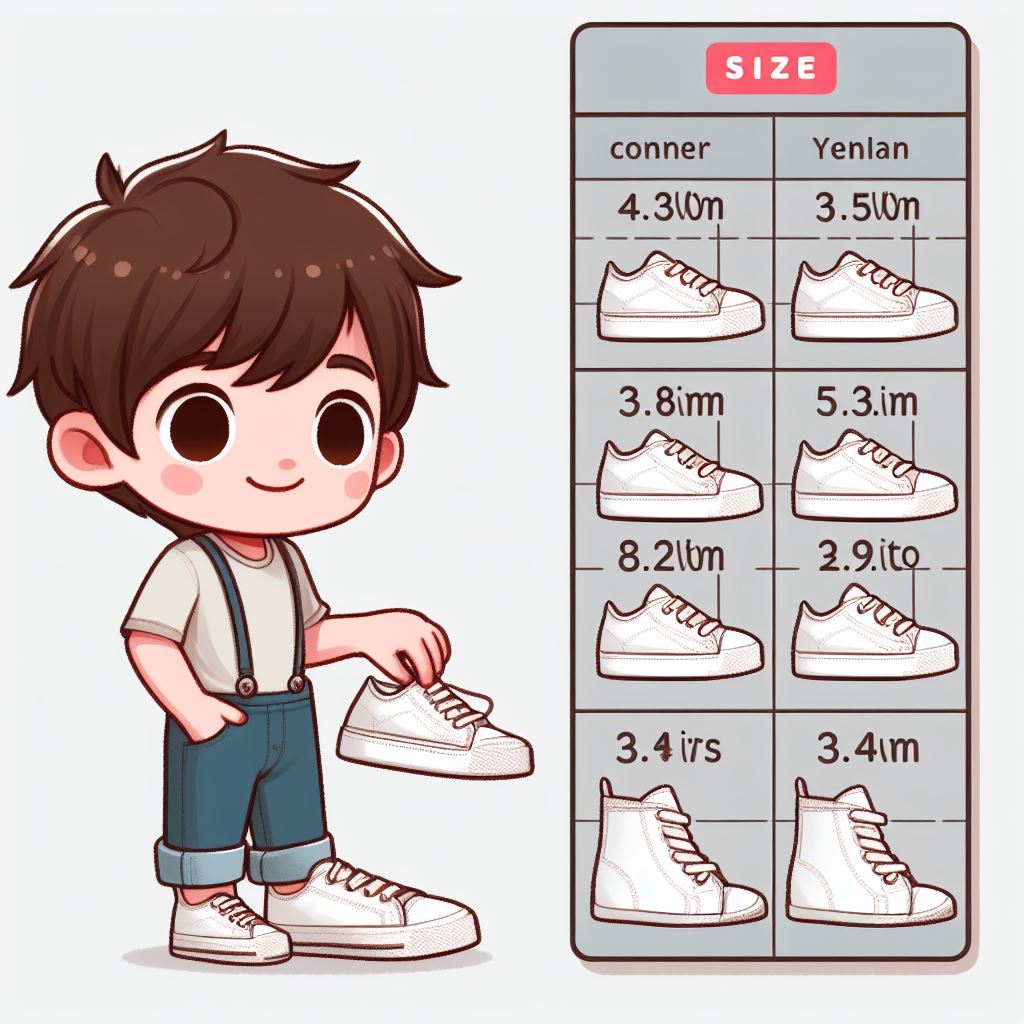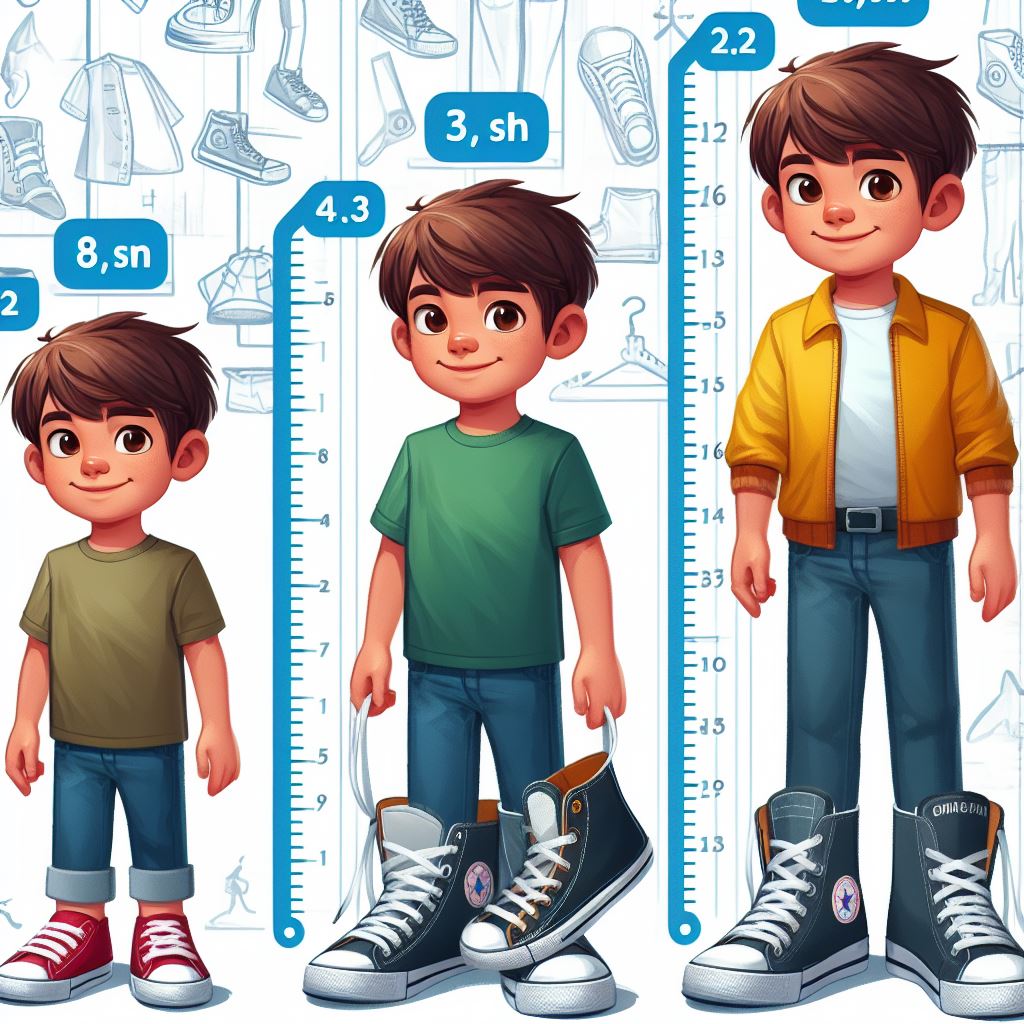Kids Shoe Size Chart By Age
Baby Shoe Size Conversions (0-12 Months)

Here’s a baby shoe size conversion chart (0-12 months) to help you find the right fit for your little one. Remember, this is a general guide and may vary slightly between brands.
| Age (Months) | Shoe Size |
| 0 | Newborn |
| 1 | 1 |
| 2 | 2 |
| 3 | 2.5 |
| 4 | 3 |
| 5 | 3.5 |
| 6 | 4 |
| 7 | 4.5 |
| 8 | 5 |
| 9 | 5.5 |
| 10 | 6 |
| 11 | 6.5 |
| 12 | 7 |
Tips for Choosing Baby Shoes:
- Measure both feet: Even tiny feet can have size differences. Choose the size that matches the bigger foot.
- Prioritize comfort and flexibility: Opt for soft, flexible shoes that allow for natural foot development.
- Consider wiggle room: Leave a little extra space (around ¼ inch) for growth and comfort, especially if your baby will wear socks.
- Look for secure closures: Velcro straps or elastic laces are ideal for easy on-and-off, especially for busy parents.
Additional Tips:
- It’s generally recommended to buy baby shoes once your child starts walking.
- Socks can help keep little feet warm, but choose sizes that fit well within the shoes to avoid cramping.
- Pay attention to any signs of discomfort like redness or blisters, which could indicate ill-fitting shoes.
I hope this helps.
Walker Shoe Size Conversions (12-24 Months)

Here’s a walker shoe size conversion chart (12-24 months) to get you started.
| Age (Months) | Approximate Shoe Size (US) |
| 12 | 4 |
| 13 | 4.5 |
| 14 | 5 |
| 15 | 5.5 |
| 16 | 6 |
| 17 | 6.5 |
| 18 | 7 |
| 19 | 7.5 |
| 20 | 8 |
| 21 | 8.5 |
| 22 | 9 |
| 23 | 9.5 |
| 24 | 10 |
Keep in mind:
- This is a general chart and may vary by brand. Shoe manufacturers use different sizing systems.
- It’s always best to measure your child’s feet for the most accurate size. Here’s a quick way to do it at home:
- Trace your child’s foot on a piece of paper while they are standing.
- Measure the distance between the farthest back of the heel to the tip of the longest toe.
- Use a shoe size chart from the specific brand you’re considering to find the corresponding size for the measured foot length.
- Consider adding a little wiggle room (about ¼ inch) to the measured length, particularly for sneakers or shoes your child will wear with socks.
Additional Tips:
- When possible, try to have your child wear the shoes while shopping to ensure a good fit.
- Look for shoes with flexible soles that allow for natural foot development.
- Choose shoes with good ankle support to help with balance as your child starts walking more confidently.
I hope this helps you find the perfect fitting shoes for your little walker.
Toddler Shoe Size Conversions (2-4 Years) edit

| Age (Years) | Approximate Shoe Size (US) | Centimeters (cm) |
| 2 | 7.5 | 15 |
| 2.1 | 8 | 15.5 |
| 2.2 | 8.5 | 16 |
| 2.3 | 9 | 16.5 |
| 2.4 | 9.5 | 17 |
| 2.5 | 10 | 17.5 |
| 2.6 | 10.5 | 18 |
| 2.7 | 11 | 18.5 |
| 2.8 | 11.5 | 19 |
| 2.9 | 12 | 19.5 |
| 3 | 12.5 | 20 |
| 3.1 | 13 | 20.5 |
| 3.2 | 13.5 | 21 |
| 3.3 | 14 | 21.5 |
| 3.4 | 14.5 | 22 |
Important things to remember.
- This is a general guide and can vary by brand. Shoe manufacturers use different sizing systems.
- It’s always recommended to measure your child’s feet for the most accurate size. Here’s a quick way to do it at home:
- Place a piece of paper on a flat surface and have your child stand on it with their heel against a wall.
- Trace their foot or mark the longest toe and the back of the heel.
- Measure the distance between the two marks in centimeters (cm).
- When choosing a shoe, add a little wiggle room (about ½ inch or 1.3 cm) to the measured length, especially for sneakers or boots.
- Toddlers’ feet grow quickly, so you might need to size up every few months.
Additional Tips:
- Pay attention to how the shoe fits around the widest part of your child’s foot.
- Look for shoes with flexible soles that bend easily and provide good arch support.
- Consider closures that are easy for your child to manage, such as Velcro straps or elastic laces.
I hope this helps you choose the perfect fitting shoes for your happy toddler.
Little Kid Shoe Size Conversion Chart (4-8 Years)

| Age (Years) | Approximate Shoe Size (US) | Centimeters (cm) |
| 4 | 11 | 22.5 |
| 4.1 | 11.5 | 23 |
| 4.2 | 12 | 23.5 |
| 4.3 | 12.5 | 24 |
| 4.4 | 13 | 24.5 |
| 4.5 | 13.5 | 25 |
| 4.6 | 1 | 25.5 |
| 4.7 | 1.5 | 26 |
| 4.8 | 2 | 26.5 |
| 4.9 | 2.5 | 27 |
| 5 | 3 | 27.5 |
| 5.1 | 3.5 | 28 |
| 5.2 | 4 | 28.5 |
| 5.3 | 4.5 | 29 |
| 5.4 | 5 | 29.5 |
| 5.5 | 5.5 | 30 |
| 5.6 | 6 | 30.5 |
| 5.7 | 6.5 | 31 |
| 5.8 | 7 | 31.5 |
| 5.9 | 7.5 | 32 |
| 6 | 8 | 32.5 |
| 6.1 | 8.5 | 33 |
| 6.2 | 9 | 33.5 |
| 6.3 | 9.5 | 34 |
| 6.4 | 10 | 34.5 |
| 6.5 | 10.5 | 35 |
| 6.6 | 11 | 35.5 |
| 6.7 | 11.5 | 36 |
| 6.8 | 12 | 36.5 |
| 6.9 | 12.5 | 37 |
| 7 | 13 | 37.5 |
| 7.1 | 13.5 | 38 |
| 7.2 | 1 | 38.5 |
| 7.3 | 1.5 | 39 |
| 7.4 | 2 | 39.5 |
| 7.5 | 2.5 | 40 |
| 7.6 | 3 | 40.5 |
| 7.7 | 3.5 | 41 |
| 7.8 | 4 | 41.5 |
| 7.9 | 4.5 | 42 |
| 8 | 5 | 42.5 |
Keep in mind:
- This is a general guide, and actual shoe sizes may vary by brand.
- It’s always best to measure your child’s feet for the most accurate size.
- Add a little wiggle room (about ¼ inch or 0.6 cm) to the measured length, especially for sneakers or shoes your child will wear with socks.
- Children’s feet grow quickly, so you might need to size up every few months.
Additional Tips:
- Pay attention to how the shoe fits around the widest part of your child’s foot. There should be some space but not too much extra room.
- Look for shoes with supportive soles and good arch support.
- Consider closures that are easy for your child to manage on their own.
By following these tips, you should be able to find the perfect fitting shoes for your little kid.
Big Kid Shoe Size Conversions (8-12 Years)

Here’s the information you’ve been waiting for: Big Kid Shoe Size Conversions (8-12 Years).
| Age (Years) | Approximate Shoe Size (US) |
| 8 | 1 – 3.5 |
| 9 | 2 – 4 |
| 10 | 3 – 4.5 |
| 11 | 4 – 5.5 |
| 12 | 5 – 6 |
Important Considerations:
- Remember, this is a general guide. Shoe sizing can vary between brands. There’s often overlap between sizes in different categories (like little kid vs big kid).
- Always measure your child’s feet for the most accurate size. Here’s a quick at-home method:
- Place a piece of paper on a flat surface and have your child stand on it with their heel against a wall.
- Trace their foot or mark the longest toe and the back of the heel.
- Measure the distance between the two marks in inches.
- Use a shoe size chart from the specific brand you’re considering to find the corresponding size for the measured foot length.
- When choosing a shoe, add a little wiggle room (around ¼ inch or 0.6 cm) to the measured length, especially for sneakers or boots. This allows for growth and comfort.
Tips for Big Kid Shoes:
- Support and Stability: Look for shoes with good arch support and a sturdy sole, especially for active kids.
- Closure Options: Consider shoes with laces or easy-to-use closures like Velcro straps for a secure and adjustable fit.
- Durability: Big kids can be tough on shoes! Choose shoes made from durable materials that can withstand wear and tear.
Finding the Perfect Fit:
While this chart provides a starting point, the best way to ensure a good fit is to have your child try on the shoes whenever possible. This allows you to check for any tightness or discomfort and assess the overall fit. Pay attention to how the shoe fits around the widest part of the foot and ensure there’s enough space for toes to wiggle without feeling cramped.
Remember, children’s feet grow quickly at this age, so you might need to replace shoes more often than with younger children.
By following these tips, you should be able to find comfortable and well-fitting shoes for your growing big kid.
Latest post